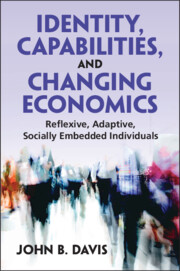Book contents
- Identity, Capabilities, and Changing Economics
- Identity, Capabilities, and Changing Economics
- Copyright page
- Dedication
- Contents
- Tables
- Boxes
- Preface
- Acknowledgments
- Part I The Failed Pathway and Exit Strategies
- Part II Building a Socially Embedded Individual Conception
- 4 Adaptive Reflexive Individuals
- 5 A General Theory of Social Economic Stratification
- 6 Roads Not Taken Yet to Be Taken
- Part III Value and Subjectivity
- References
- Index
5 - A General Theory of Social Economic Stratification
Stigmatization, Exclusion, and Capability Shortfalls
from Part II - Building a Socially Embedded Individual Conception
Published online by Cambridge University Press: 11 January 2024
- Identity, Capabilities, and Changing Economics
- Identity, Capabilities, and Changing Economics
- Copyright page
- Dedication
- Contents
- Tables
- Boxes
- Preface
- Acknowledgments
- Part I The Failed Pathway and Exit Strategies
- Part II Building a Socially Embedded Individual Conception
- 4 Adaptive Reflexive Individuals
- 5 A General Theory of Social Economic Stratification
- 6 Roads Not Taken Yet to Be Taken
- Part III Value and Subjectivity
- References
- Index
Summary
Chapter 5 turns to social embeddedness, describes this in terms of two kinds of social identities people have, and explains how a world stratified by social groups produces two kinds of shortfalls in the capability development of people in disadvantaged social groups. First, a microlevel mechanism, social group stigmatization, or social identity stereotyping operates in relational social identity settings, limits stigmatized individuals’ ability to develop their capabilities, and results in what I call capability devaluations. Second, a macro-level process, sorting people over club goods and common pool goods types of social economic locations, produces social group inequalities especially by race/ethnicity and gender, limits lower ranked groups’ capability development, and results in what I call capability deficits. How these two kinds of capability shortfalls combine and reinforce a hierarchical ordering of social groups is explained using a basic complexity theory analysis from Simon. Combatting these two capability shortfalls – motivated by the goal of creating nonhierarchical, democratic societies that promote individuals’ capability development irrespective of social identity – is associated with policies to eliminate social discrimination in the case of capability devaluations and to advance social group reparations in the case of capability deficits.
Keywords
- Type
- Chapter
- Information
- Identity, Capabilities, and Changing EconomicsReflexive, Adaptive, Socially Embedded Individuals, pp. 109 - 134Publisher: Cambridge University PressPrint publication year: 2024



